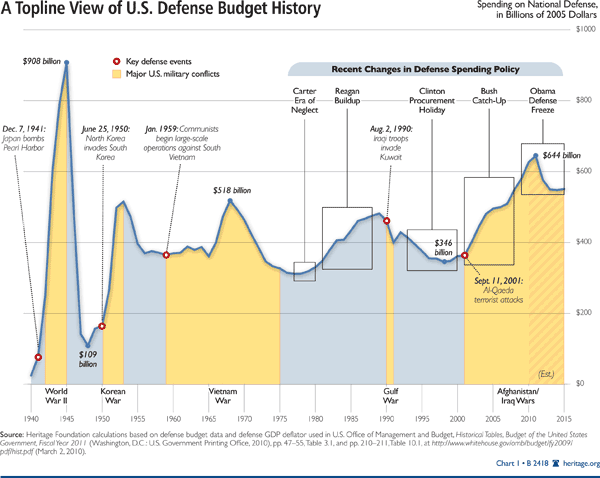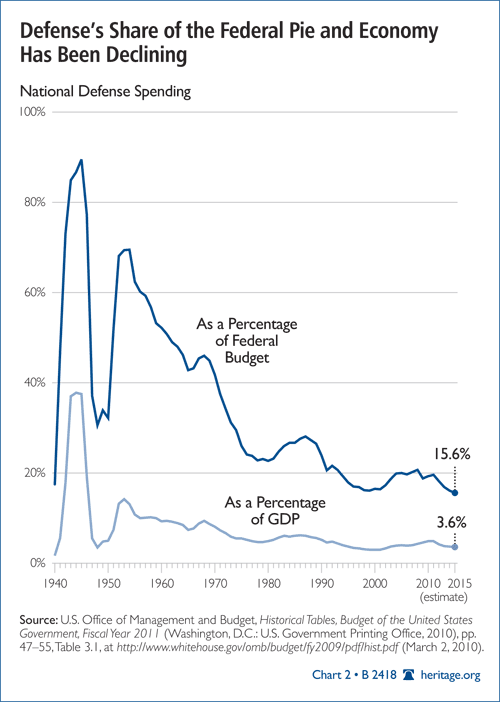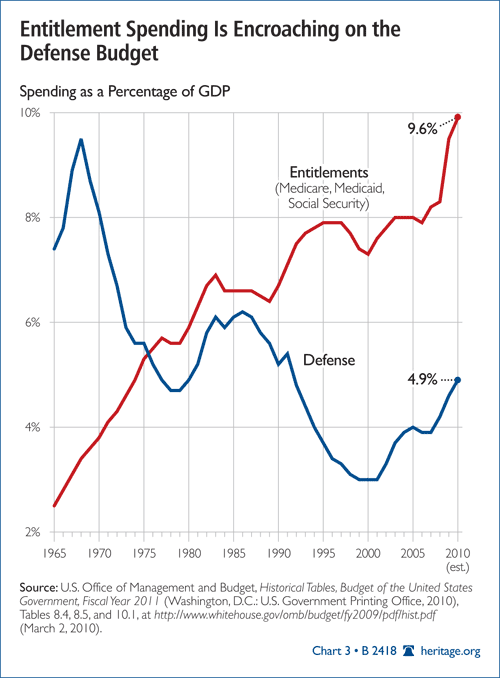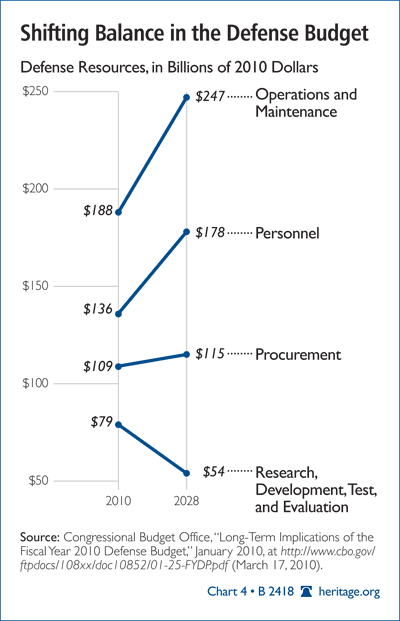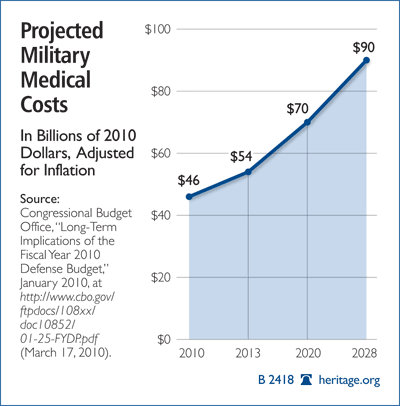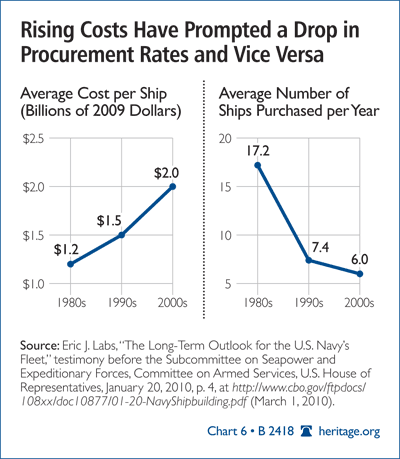Abstract: President Barack Obama’s defense budget request perpetuates a long-standing pattern of underfunding defense needs. Defense spending is already near historic lows, and the Administration’s budget would reduce it to levels unprecedented during wartime. Furthermore, Congress appears poised to repeat the past mistake of promptly disarming after major combat operations subside. Instead, Congress should maintain current levels of defense spending to allow the military to reset and recapitalize. Congress needs to control entitlement growth, domestic spending, and public debt, which are beginning to threaten national security. Congress also needs to reform military compensation to ease strains within the defense budget.
President Barack Obama’s fiscal year (FY) 2011 defense budget request[1] would increase the defense topline by between 1 percent and 2 percent in real terms. However, even with this modest increase, the budget is still insufficient to pay the Pentagon’s bills. In fact, the nation’s defense plans have become so chronically underfunded that most defense analysts dismiss the out-year projections in the Pentagon’s five-year budget plan as implausible.
The news that the defense budget is inadequate to meet the nation’s security plans may come as a surprise to many Members of Congress who approved cuts in nearly 50 defense programs in FY 2010. Noting that the defense budget has been growing since 9/11, some observers argue that there should be no problem. However, despite the post-9/11 budget increases, defense spending is still tight, and core defense capabilities are being shortchanged.
Congress needs to acknowledge this problem and openly confront the situation with realistic solutions. Congress can begin to address the mismatch between defense strategy and resources by providing more predictable defense outlays, controlling domestic spending, aligning military compensation with the needs of a highly mobile 21st-century workforce, increasing foreign military sales, and instituting performance-based logistics. The government’s obligation to provide for the common defense deserves nothing less than policymakers’ best efforts, not another period of disarmament after major hostilities cease.
Strains on the Defense Budget
Most Americans believe the U.S. government spends far more on defense than it actually does. Defense spending is near historic lows, however, and the Administration’s proposed five-year budget plan would further reduce defense spending to levels unprecedented during wartime. Between 2010 and 2015, total defense spending is set to fall from 4.9 percent to 3.6 percent of gross domestic product (GDP), even though the nation has assigned more missions to the military over the past two decades. This growing disparity between funding and requirements is the primary cause of the increasing strain on the defense budget, but numerous other external and internal factors also are contributing to the problem.
External sources of strain outside the Pentagon’s control include:
- Historical hangovers. Years of underinvestment in defense, especially during the 1990s, have had lasting effects on the defense program. Efforts to remedy the problem and play catch-up have been insufficient to rebuild the military.
- Crowding out by entitlements. The exploding costs of domestic entitlements and health care are placing severe pressure on the defense budget. If their growth is left unchecked, they could soon consume every dollar of federal revenue, completely crowding out defense spending.
- Internal strains include:
- Defense entitlements. Paralleling trends in the larger federal budget, key defense spending priorities are being overtaken by escalating personnel compensation costs, including numerous deferred and in-kind benefits. Modernization funds for new planes, ships, aircraft, vehicles, and other weapons systems are being hit the hardest.
- Shrinking economies of scale and defense inflation. Military modernization accounts are under further duress because the cost of military equipment is rising faster than the overall defense budget and outpacing inflation in the wider economy. The problem is caused largely by declining build rates and lost economies of scale. Other factors include the rising costs of fuel, input materials, labor, and increasingly complex systems.
Unless Congress addresses these unsustainable trends in the larger federal budget and within the defense budget itself, these problems could reinforce one another, devastating military modernization by forcing another procurement holiday. This would severely reduce the military’s fighting capability for decades to come.
America’s defense investment crisis may have already begun. Modernization funding (the procurement account plus the research, development, test, and evaluation account) is projected to stagnate in FY 2011 and then decline in subsequent years. Planned defense cuts over the next five years will exacerbate the problem, further reducing build rates, overall efficiency and possibly shrinking competition further. However, before addressing defense spending imbalances, Congress should first ensure that it has correctly identified and defined the problem.
External Causes of Defense Budget Erosion
In 1994, in a seminal paper on defense planning, defense analyst Kevin Lewis charted “a topline view of our budget history.”[2] Chart 1 updates this exercise and presents an overview of total spending on national defense between 1940 and 2015 in constant FY 2005 dollars.[3]
The defense topline reveals disturbing trends. As Lewis pointed out more than a decade ago, the defense budget experienced “slow erosion” during most periods of recent U.S. history, interspersed with event-driven booms. Unsurprisingly, these swings in the defense budget have undermined the development of a stable, coherent defense program designed with sufficient regard for the long term.
World War II, the Korean War, the Vietnam War, the Cold War, and the attacks on September 11 each prompted sharp increases in defense spending. The resulting defense hikes were necessary because they were preceded by periods of inadequate investment, which produced military shortcomings that were often fully exposed only when troops entered combat.
During each war, the bulk of the new spending went toward the specific mix of capabilities required to prevail in the contingency of the day. For example, Lewis notes that Washington procured large numbers of fighter jets during some years of budget plenty, but these systems reached the end of their service lives at the same time, producing a requirement for a major investment initiative to prevent inventory obsolescence.[4] Inadequate measures to stabilize the force will produce predictable capability shortfalls in the near future.
Today’s looming tactical fighter deficits in the Navy, Marine Corps, and Air Force illustrate how erratic defense spending can impose larger, deferred costs on taxpayers. In 2008, Air Force officials projected a fighter shortfall of up to 800 aircraft by 2024, and Navy officials projected a shortfall of up to 200 aircraft by 2018.[5] Although more optimistic studies project smaller shortfalls, the Pentagon’s plans to narrow the fighter gap will probably prove to be too little too late.
After each war-driven boom, the defense budget has experienced an extended period of decline. In May 2007, U.S. Secretary of Defense Robert Gates explained:
Five s to times over the past 90 years—after the First and Second World Wars, Korea, Vietnam and most recently after the Cold War— the United States has slashed defense spending or disarmed outright in the mistaken belief that the nature of man or the behavior of nations had changed with the end of each of the wars, or that somehow we would not face threatour homeland or would not need to take a leadership role abroad.[6]
Time and again, policymakers have tended to neglect defense absent immediate, manifest threats to U.S. interests, and Americans and their military personnel have repeatedly paid the price of being less prepared.
Common sense dictates that the Pentagon should take advantage of peacetime lulls to replace damaged or destroyed equipment, to modernize legacy systems, and to purchase next-generation replacements to avoid predictable shortfalls in future force structure. Yet most Administrations have failed to do so.
Procurement Holiday. The most recent period of slow erosion was the “procurement holiday” during the 1990s. With bipartisan support in Congress, the Clinton Administration drastically cut defense spending after the collapse of the Soviet Union in the overly optimistic belief that an era of relative peace would ensue. Purchases of new weapons fell particularly sharply, resulting in a near freeze in the development of new planes, ships, and vehicles. Indeed, the U.S. did not purchase a single tactical fighter jet in 1995.[7] Unsurprisingly, the U.S. military shrank by one-third across the board, and the average ages of most major platforms doubled.
This is the military that went to war in Afghanistan and Iraq after 9/11 and is still deployed today. It is essentially the military that Ronald Reagan built.
During the 1990s, policymakers chose to invest in service-life extensions of Reagan-era platforms instead of new equipment. This increased the bill for maintenance, repairs, and upgrades but only delayed (and increased) the bill for modernization. Weapons systems can be patched up for only so long before they retire completely. Equipment eventually falls apart, breaks down, or becomes too hazardous and costly to use. The 1990s modernization hiatus merely deferred the cost of replacing aging platforms that were built in the 1970s and 1980s—even while the need for replacements remained constant.
Under President George W. Bush, the defense budget grew significantly after the 9/11 terrorist attacks, but the bulk of the increase was consumed by operations in Afghanistan and Iraq. The relentless demands of wartime operations forced the Administration to prioritize endstrength growth and investment in counterinsurgency capabilities while capping investment in resetting the force and developing new capabilities. As a result, the U.S. military has yet to fully recover from its procurement hangover during the 1990s.
Inaccurate Cost Estimates, Poor Planning, and Systematic Underfunding. Another deficiency in the defense planning process is the systematic tendency of planners to underestimate costs and requirements. This leads Congress to appropriate inadequate funding at the front end of procurement programs, which results in unexpected, unbudgeted costs later in the process.
Stephen Daggett, a specialist in defense policy and budgets at the Congressional Research Service (CRS), has testified before Congress about how defense cost estimation has become far less accurate in recent years:
On average, in 2000, DoD underestimated the R&D cost of weapons programs by about 27 percent, which in itself is not very good. But, in 2007, they underestimated R&D costs by an average of 44 percent. If you look at it from the point of view of the impact on the overall budget, cost growth in the 2007 inventory of major weapons is projected now to total about $300 billion, which is more than a year’s worth of weapons acquisition, and it is about 18 percent cost growth over initial projections. So, in effect, we are losing…our ability to acquire almost one-fifth of the weapons we plan to buy because we underestimate cost.[8]
Lowball cost estimates are symptoms of the government’s wider inability to examine the future and make accurate predictions about defense investment. Granted, many of today’s weapons systems, such as bombers, were built decades ago for different missions and have since been adapted to irregular warfare operations in Iraq, Afghanistan, and other places. However, as Lewis cautioned in 1993, history suggests that the U.S. frequently underestimates the forces needed for contingencies while overestimating the capabilities generated by its defense programs.[9] The U.S. also has a poor record of predicting and preparing for emerging security threats.
Exploding Entitlements and Interest Payments. Although the boom-and-bust defense pattern has become relatively routine over the past six decades, the next bust may be particularly deep given America’s dire fiscal position and runaway spending. The rapid expansion of domestic entitlements, the recent passage of costly health care legislation, and the unprecedented growth of public debt are certain to create extraordinary pressure for further cuts in the defense budget.
These cuts would come at a time when defense’s share of the federal budget is already shrinking. Defense claimed almost 90 percent of the federal budget during World War II, 70 percent during the Korean War, about 50 percent during Vietnam, and about 30 percent during the Cold War. Today, defense accounts for less than 20 percent of the federal budget and is falling. President Obama’s budget plan would reduce defense spending to just 15.6 percent in FY 2015, before accounting for the effects of health care reform.[10]
The substantial decline in the defense share of the budget largely reflects the dramatic growth of entitlement spending. Entitlements now account for around 65 percent of all federal spending and a record 18 percent of GDP.[11] The three largest entitlements—Social Security, Medicare, and Medicaid—eclipsed defense spending in 1976 and have been growing ever since. If future taxes are held at the historical average, these three entitlements will consume all tax revenues by 2052, leaving no money for the government’s primary constitutional obligation: providing for the common defense.[12]
Furthermore, with deficits at record levels and interest payments on the national debt set to rise at a real rate of 13 percent annually over the next 10 years, interest payments could reach $725 billion and exceed defense spending by 2018[13] if not sooner.
With so much of the federal budget allocated to mandatory spending, this Administration—like others before it—will increasingly look to national defense as a bill payer. Roughly half of the Obama Administration’s $17 billion in government spending cuts for FY 2010 was found in the defense budget. These cuts included reductions in or terminations of 16 major programs and numerous smaller ones.[14]
Defense is often seen by policymakers as an attractive pot of cash that can be raided without obvious or immediate consequence. Of course, in the long run, lower defense spending leads to a smaller force, reduced troop readiness, longer deployment times, less capable weapons systems, and ultimately the de facto or overt abandonment of America’s security commitments around the world.
Internal Causes of Defense Budget Imbalance
Trends within the defense budget parallel those in the wider federal budget. In the 1990s, defense analysts noted that overhead costs for functions such as operational support, health care, basing structure, and administration (overhead) were accounting for increasing shares of the total budget.[15] The pattern has only become more pronounced in the past decade.
Unsustainable Growth in the Operations and Support Accounts
The portion of the defense budget devoted to operations and support (O&S), which includes the military personnel account and the operation and maintenance (O&M) account, is expected to grow to 64.5 percent of the total defense budget in 2011 and 72 percent by 2028. This is more than double the share allocated to military modernization.[16]
The imbalance stems in large measure from the growing cost of compensating America’s all-volunteer force. The cost of paying the military, particularly deferred and in-kind benefits that are often unfunded entitlements, is rising unsustainably despite only marginal increases in the number of ground force troops and recent reductions in Navy and Air Force endstrength. If these benefits continue to grow while the overall defense budget remains flat, funding them will require taking ever more money from modernization programs to pay personnel.
The Congressional Budget Office (CBO) projects that the situation will only grow worse. Between 2010 and 2028, the military personnel account is projected to increase from $136 billion to $178 billion (in constant 2010 dollars), and the O&M account is projected to grow from $188 billion to $247 billion. At the same time, modernization accounts will stagnate or fall in real terms.[17] In a recent conference call with defense analysts, Under Secretary of Defense (Comptroller) Robert Hale confirmed that the Department of Defense (DOD) may need to rob modernization to cover O&M growth,[18] essentially mortgaging the future force to pay for present needs.
Escalating Cost of Military Benefits. Military medical programs account for almost half of the recent growth in O&S funding. The CBO estimates that real spending on medical programs will more than double under the Pentagon’s current plans, from $44 billion in 2009 to $90 billion in 2028, far outpacing inflation in the wider economy. Pharmaceutical spending alone will increase by about 120 percent, direct care costs by more than 90 percent, and the cost of purchased care and contracts by around 125 percent.[19] As has often happened in the defense budget and in the U.S. economy, medical costs could rise even faster than anticipated.
Over the past decade, Congress has added new pension benefits and authorized large pay increases, all of which are contributing to rising personnel costs. For example, retirement pay for military personnel who retire after 20 years of service was increased in 2000 from 40 percent to 50 percent of a servicemember’s basic pay. In addition, the FY 2000 defense authorization bill enacted TriCare for Life, expanding health care coverage for military retirees and their families.[20]
The retirement annuity for surviving spouses of servicemembers was also increased from 35 percent to 55 percent of the deceased’s retirement pay,[21] and the retirement age for some members of the Reserve Component has been lowered to 60. The costs of these benefit expansions are compounded by military pay increases. As the CBO points out, “higher basic pay today leads to higher projections of future annuities, in turn requiring larger payments today from the military personnel accounts into the retirement fund.”[22]
Military pay raises are automatically linked to the Employment Cost Index, an index of wage growth in the private sector, but Congress authorized additional wage increases on many occasions in the past decade in an attempt to reward the all-volunteer force for service during protracted wars and to reduce the perceived civil–military “pay gap,” which has since been eliminated. The long-term result, however, has been a significant increase in the cost of compensation benefits that are indexed to basic pay. While these pay increases were necessary (and certainly deserved) to recruit and retain the all-volunteer force, many were not enacted under budget rules to ensure that they were paid for in future years.
High Wartime Operations Tempo. Constant wartime deployments of manpower and materiel for missions in Afghanistan and Iraq are another internal strain on defense budgets. An increasingly large portion (60 percent, according to the DOD Comptroller) of the account for overseas contingency operations (OCO) is paying for maintenance, replacements, repairs, and other costs associated with a higher-than-usual pace of operations.[23]
According to the Center for Strategic and International Studies, the projected costs of replacing vehicles, armor, and helicopters already exceed the Army’s budget by billions of dollars each year.[24] The outlook will only grow darker for the services, particularly ground forces, whose leaders have long told Congress that the cost of resetting the force will remain significant after major combat operations subside.
During numerous budget hearings, members of the Joint Chiefs have testified repeatedly that the services will continue to need billions of dollars for at least three years after operations in Iraq conclude to repair and replace equipment damaged during combat operations. Marine Corps Commandant General James Conway testified in February 2008, “Reset funding has partially alleviated this strain, but continued funding is needed as we are simply running short of aircraft on our flight lines due to age, attrition, and wartime losses.” While reset programs have helped to mitigate degradation of aircraft readiness through modifications, proactive inspections, and additional maintenance actions, the additional requirements for depot-level maintenance on airframes, engines, weapons, and support equipment will continue well beyond the conclusion of hostilities.[25]
The Costs of Maintaining an Aging Force. In addition to the wartime damage sustained by military equipment, ordinary aging imposes significant costs. As the average ages of many planes, ships, and vehicles increase, so does the cost of maintaining and repairing them.
One example is the KC-135 Stratotanker. Various press reports have discussed the high cost of maintaining this old platform.[26] These tankers were built during the Eisenhower Administration, and many are more than 50 years old. They are often grounded because of leaks or broken parts, sometimes for weeks as Air Force engineers cannibalize old tankers for spare parts or recreate them from scratch. Old systems like KC-135 tankers are an additional drain on resources because they are less fuel efficient than newer platforms.
Another example is the Army’s ground combat vehicle fleet. With the cancellation of its Future Combat Systems program, the Army will need to upgrade its entire fleet of medium-weight combat vehicles at an annual cost of $200 million from 2010 through 2021. Revitalizing the aging Abrams tanks and Bradley vehicles will cost an additional $2 billion annually.[27] Production of a new ground combat vehicle is not scheduled to begin for about seven years.
This is a common story across the services. Scarce defense funds are being used to maintain, repair, upgrade, and fuel old platforms that badly need to be replaced by more efficient next-generation systems. While patching up older systems may appear to save money up front, replacing them outright often brings its own savings through reduced crew size, more efficient energy usage, more capable and advanced technology, and better networking capabilities.
War Funding Shifts to the Core Defense Budget. The defense budget will endure additional strain as select funding from the OCO budget is continuously shifted into the base defense budget. The Pentagon’s FY 2011 defense budget overview explains that war funding requests will no longer be used to make up for base budget shortfalls and that certain types of funding have been moved from OCO requests to base budget requests. The document states further that the Defense Department “will explore additional OCO-to-base shifts in future budgets.”[28]
Of particular note is the outright confession by Pentagon leaders that the base defense budget has shortfalls in the first place. While moving away from using emergency supplementals to fund the wars overseas is a positive procedural development, the core defense budget cannot fully absorb all of the excess warfighting costs unless its topline is increased accordingly. The defense budget process is already zero-sum, and irresponsibly shifting OCO bills without providing adequate funding to pay for them will further reduce each account’s share of the defense budget.
Rising Unit Costs and Lost Economies of Scale. Within the procurement account, defense inflation— the rising unit costs of defense platforms—is an additional source of pressure. Military equipment is becoming more expensive primarily because it is becoming increasingly advanced technologically. Other cost drivers include a shrinking workforce in the design, engineering, and manufacturing sectors and soaring prices for input materials, including certain metals. In addition, per-unit overhead costs at production facilities have increased as the total number of units produced has declined. The overall result in the shipbuilding industry, for example, has been that “the cost of building ships has been rising about 1.4 percent faster per year than the prices of final goods and services in the U.S. economy.”[29]
Generally, the military services have responded to rapid cost growth by reducing procurement rates, thereby creating a vicious cycle. For example, during the 1980s, the Navy purchased more than 17 ships per year at an average cost of $1.2 billion (in 2009 dollars) per ship. By the 2000s, the average cost had increased to $2.0 billion per ship for about six ships per year.[30]
Falling procurement has then fed back into a cycle of further cost growth as defense production has suffered from economies of scale. As former Senator Jim Talent has explained:
The Defense Department regularly projects what it intends to buy in the out years of its defense plan, but then institutes last-minute cuts, changes, and delays that allow it to meet annual budget targets but increase program costs in the long run. The Navy, for example, originally planned to buy a total of 32 DDG-1000s—the Navy’s next-generation multi-mission destroyer. A few years later, Navy officials said the military requirements had dropped to only eight to twelve destroyers, and the most recent Navy plan now calls for a total of only seven. It is no coincidence that over the same period, due to the loss of economies of scale, the cost per destroyer has increased.[31]
In turn, increasing costs have reduced acquisition plans even further, perpetuating the dysfunctional cycle at enormous cost and with significant consequences for the force. While purchasing more advanced equipment can offset Pentagon decisions not to replace systems on a one-for-one basis, there are limits to this approach. At some point, sheer numbers outweigh the advantages of advanced capabilities because each ship, plane, and vehicle can be in only one place at one time. If the U.S. intends to continue fulfilling its commitments around the globe, increasing capability alone is not enough. It must be backed by a sufficient quantity of next-generation systems.
After more than a decade and millions of dollars in funding, only three DDG-1000s are being built. Recent defense procurement is replete with similar examples of programs that have been terminated short of originally planned numbers or that have entered the dreaded defense “death spiral.” The Army’s Future Combat Systems program, the program to replace OH-58D Kiowa helicopters, the Marine Corps’ Osprey program, and the F-22 tactical fighter program have been truncated or eliminated, largely as a result of unbudgeted cost growth. Ultimately, all of these programs have suffered from disconnects between the Defense Department’s proposed plans and annual budgets.
Acquisition Reform Without Significant Procurement Account Growth. For more than a century, think tanks and congressional oversight bodies have produced numerous studies on acquisition problems. Regrettably, many of the changes implemented to streamline the defense acquisition system have instead added layers of regulations and complex requirements that have made the process less competitive, more costly, and more cumbersome. For the most part, these efforts have failed to rein in costs or alleviate schedule delays. Instead, additional layers of red tape, combined with a growing number of personnel to oversee a declining number of new programs, have only exacerbated cost increases and schedule delays[32] without adding accountability to the process.
Delays and cost overruns that were often the result of government changes, not contractor inabilities, have the added consequence of making weapons systems easy political targets. Meanwhile, the underlying causes of cost growth—such as barriers to entry in the defense market and excessively demanding regulations and standards—are often poorly understood.
The favored solution of many policymakers, including those in the Obama Administration, is often simply to slash “underperforming” programs. In the long run, cutting or delaying programs to reap savings has often been spectacularly counterproductive. Overhead costs have remained high and bureaucracies have often increased despite falling production rates. Former Secretary of the Navy John Lehman illustrates the point:
There were about 1,000 people in the Bureau of Ships during World War II…. And they were the ones that mainly ran the shipbuilding program—not micromanaged the contractors, but developed and did the systems integration and oversaw the program. Through World War II, they built on average about a thousand ships a year. That’s one ship per person.
Now in my day, there were 4,000 people in the Bureau of Ships, and we averaged 28 ships a year.
…Today, we’re averaging about 6 to 7 ships a year, and there are 25,000 people in the equivalent of the Bureau of Ships. That’s a whole Pentagon-load of people in the Bureau of Ships. Now they’re scattered all over the country in different offices and functions, but the numbers are—you can get into lots of quibbles about it—but the numbers increased, 1,000; 4,000; 25,000 as the numbers of ships decline precipitously.
And so what’s the answer? Reform? We have a new budget that will add 20,000 additional civil servants to oversee the already-bloated layers of bureaucracy that are there today.[33]
Recently, Pentagon leaders have expressed some political will to remove red tape and loosen protectionist arms trade restrictions that have helped to inflate costs,[34] but more must be done. Any effective acquisition reform efforts must be paired with increased procurement funding to buy more needed systems.
America’s Defense Budget Gap. The biggest problem by far is the growing mismatch between defense resources and plans. One side of the political spectrum often argues that the Pentagon’s plans are too broad. The other side states that defense budgets are too low. From both perspectives, it should be obvious that there is a huge and growing disconnect.
Dr. Michael O’Hanlon, a defense budget expert at the Brookings Institution, has observed that President Obama’s 2010 defense budget plans are “insufficient to support the national security establishment over the next five years.” O’Hanlon argues that by adopting a policy of zero real growth in the base budget, the Administration will leave the U.S. military with a cumulative requirement gap of about $150 billion between 2010 and 2014.[35] In explaining this, O’Hanlon identifies many of the pressures discussed above:
For the Defense Department to merely tread water a good rule of thumb is that its inflation-adjusted budget must grow about 2 percent a year (roughly $10 billion annually, each and every year). Simply put, the costs of holding on to good people, providing them with health care and other benefits, keeping equipment functional, maintaining training regimes, and buying increasingly complex equipment tend to grow faster than inflation.[36]
Similarly, Travis Sharp of the Center for a New American Security has noted that Congress will need to “increase defense spending and to keep it elevated for most of the next two decades…to execute existing initiatives.”[37] Sharp elaborates that “the DoD base budget must average 567 billion dollars per year between 2011 and 2028 in order to carry out current plans.”[38]
Taking unbudgeted costs into account, a recent CBO report estimated an even larger shortfall. It calculated that carrying out DOD plans for 2010 and beyond could require an annual base budget of $632 million (in 2010 dollars) through 2028— a figure 18 percent higher than current 2010 funding levels.[39]
The persistent mismatch between defense plans and budgets translates into gaps in each of the military services’ capabilities. CSIS estimates that “today’s shortfalls in the Army alone may exceed the size of the entire Army budget pre-9/11.”[40] Congressional Research Service analyst Stephen Daggett estimates that the Army’s requirement gap is between $30 billion and $40 billion and has testified that the Navy’s shipbuilding plans and Air Force’s aviation plans are similarly underfunded.[41]
The immediate consequence is that many high-priority defense programs are being cut or cancelled because of artificial budget constraints, not because of changing military requirements. On February 22, Representative Howard P. “Buck” McKeon (R–CA) released the services’ lists of unfunded priority programs. They totaled $548 million for the Air Force, $359 million for the Army, $532 million for the Navy, and $351 million for the Marine Corps.[42] The long-term consequence is that the Defense Department is failing to build the capabilities that it has long identified as necessary to defend America’s interests.
Solving the Problem
Closing the gap between the Defense Department’s modernization requirements and the funding allocated by Congress will require honestly assessing the underlying causes and repudiating failed solutions. Congress should specifically reject defense program cuts masked as acquisition reform.
In March, Deputy Defense Secretary William Lynn touted the cancellation of seven major programs, including the C-17 cargo aircraft and the alternate engine for the Joint Strike Fighter, as major acquisition reform successes.[43] Killing programs is a simple way to show immediate dollar savings, but it will not change how the military actually buys equipment or address underlying problems. Furthermore, cutting current investment in next-generation systems will simply balloon future bills. It will also expose servicemembers to greater risks on the battlefield and further reduce the military’s capabilities.
Instead of temporary measures to reduce today’s outlays, Members should pursue true reforms that will restructure troubled programs and restore long-term efficiencies. Congress should take steps designed to alleviate each of the budget pressures identified, taking into account competing demands for the marginal defense dollar and prioritizing the maintenance and improvement of core defense capabilities.
To ensure that resources are allocated wisely, Congress should:
-
Smooth the defense budget peaks and valleys through more predictable outlays. Through its annual budget resolutions, Congress should sustain a defense topline that outpaces inflation for at least three years after the wars in Iraq and Afghanistan subside. Members should pursue this even though it will likely require adding funding to the President’s annual budget request. This is particularly important given that a flat defense budget is really a declining defense budget because the cost growth of personnel and O&M typically outpaces inflation by 3 percent to 8 percent annually.
Furthermore, when current operations wind down, Congress will likely be pressured to cut defense spending, but reducing the budget at that time will prevent the armed forces from resetting and recapitalizing effectively. The Pentagon will also need to broaden military training and modernize aging systems with next-generation programs. Relieving the strains of wartime deployments will give the Pentagon greater flexibility in a stable, predictable defense budget to improve overall readiness levels and develop coherent programming plans.
-
Control entitlement growth, domestic spending, and public debt. Congress urgently needs to begin substantively addressing entitlement reform as a national security challenge, both for the sake of the government’s fiscal health and to fulfill the government’s constitutional responsibility to provide for the common defense. Necessary reforms include gradually raising the retirement age to reflect longer life expectancies and reducing Medicare subsidies for upper-income taxpayers.[44]
Congress should also reform the budgeting process to put entitlements on a more level playing field with other priorities. It could do this by including unfunded entitlement obligations as a topic for consideration during annual budget debates and by establishing a long-term obligation limit. Additionally, Congress should introduce a process for scoring major policy proposals over the long term, not just the current budget window, and should consider creating a long-term budget for entitlement programs.[45]
-
Align military compensation with 21st century workforce demands. Congress knows that it needs to reform how the Pentagon pays its uniformed personnel, but it keeps delaying the inevitable. Military compensation is too heavily skewed toward deferred and in-kind benefits, which poorly reflect the demands of America’s highly mobile workforce. The vast majority of men and women serving in the all-volunteer force today will not remain in uniform for a full 20 years.
Congress should promote the principles of choice and flexibility for military benefits, particularly health care and retirement. Military compensation should be adjusted to provide more cash up front, which will give servicemembers greater mobility throughout their careers. Congress should change the compensation system toward a continuum-of-service model that allows troops more flexibility in moving between the reserve and active-duty components and into and out of the military, private sector, and civil service.
Congress should also reform military health care by shifting new enlistees to a defined-contribution health care system that they can take with them to different jobs and employers, whether government or private. Congress should eliminate TriCare copayments for preventative services to encourage enrollees to seek preventative care early, improve their health, and reduce overall medical costs.
-
Address the primary causes of defense inflation. By maintaining a stable defense topline and better paying military personnel, Congress can ensure the health of the defense modernization accounts. Robust and stable modernization funding will support higher and more efficient production rates, restore economies of scale, and cut unit production costs.
Avoiding budget spikes would also provide stability in defense planning and offer a steadier workload for the industrial base. When budget requests change dramatically from year to year, the industrial base cannot plan with confidence, and this increases the cost of individual systems. U.S. national security is best served by a competitive industrial base, and defense budget predictability will contribute to this effort.
-
Increase foreign military sales. Government leaders need to further ease restrictions on sales of select platforms to U.S. allies and partners both to achieve more efficient production rates and to offset costs borne by the U.S. taxpayer. Increased military sales to and purchases from reliable allies will strengthen America’s defense industrial base by increasing America’s participation as a producer and consumer in the global defense market.
Understanding that it is impossible to find a single, standard, globally applicable export policy, Congress should rationalize export controls to include fewer restrictions and licensing requirements for more reliable allies and give them greater consideration as cleared suppliers of sensitive military technologies. This will involve paring back controls, such as International Traffic in Arms Regulations. Deregulation of the defense market will also enable newer, smaller suppliers to enter the defense sector, thereby increasing competition and reducing costs.
As a first step in this overall process, the Senate should consider two pending treaties that would exempt the United Kingdom and Australia, the two most reliable U.S. allies, from various restrictions.
-
Increase international defense cooperation. Congress should support greater allied involvement and burden sharing in procurement, research, and development. The U.S. should facilitate partnerships with allies during the development phase of weapons programs when feasible.
One example of such collaboration is the partnership of the U.S., the U.K., Australia, Denmark, Italy, Turkey, Canada, and Norway in funding the development of the F-35 Joint Strike Fighter. The U.S. is the prime customer and investor, but member nations are contributing substantially to the costs. Foreign purchases of the F-35, which are expected to make up a significant portion of overall sales, will help to reduce the unit cost paid by the U.S. government.
- Continue to reform the wider acquisition process. Improving and updating the military’s acquisition process will require that Congress take the lead on initiating a wider reform agenda, including restoring systems engineering teams within the acquisition buying divisions, simplifying acquisition criteria, carrying competition well into the production phase, and carefully deregulating the defense market to remove barriers to entry.
- Support performance- based logistics management. This little-understood logistics management process is based on forging partnerships between DOD employees and industry at the military’s logistical centers in the U.S. and abroad. For it to continue to succeed, Congress will need to explore additional opportunities to apply performance-based logistics as part of defense systems lifecycle management. This will require establishing a pilot program to identify the barriers to expanded public–private partnerships in logistics.[46]
Conclusion
Congress appears poised to repeat past mistakes by voluntarily disarming when operations in Afghanistan and Iraq eventually wind down, starting another period of defense underinvestment and decline. Despite requirement shortfalls dating from the 1990s, the Administration is planning to cut the defense budget, even though the existing budget is inadequate to repair, rehabilitate, and replace equipment worn down in combat, much less diversify the force and build the capabilities required to maintain current margins of U.S. military superiority.
Five times in the past century, the U.S. has fought a major war and then promptly disarmed, with damaging and avoidable consequences. Congress should not repeat the same mistake yet again. Instead, Congress should dare to take a longer perspective by justifying robust defense spending to voters in terms of the national security and economic benefits produced by a sound defense investment and modernization strategy.
Mackenzie Eaglen is Research Fellow for National Security in the Douglas and Sarah Allison Center for Foreign Policy Studies, a division of the Kathryn and Shelby Cullom Davis Institute for International Studies, at The Heritage Foundation. Julia Bertelsmann, Research Assistant for Defense Studies in the Allison Center, assisted with the preparation of this report.

